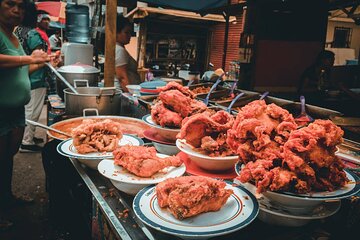The Original Cebu City Historical and Food Walking Tour
Share this tour

Offered languages
- English
Cebu is the country's oldest city and was the first Spanish settlement and the Capital of the Philippines.
Guests will witness first-hand Filipino way of life and business by walking around downtown Cebu which is often called the oldest and shortest national road in the Philippines.
Cebu City has a deeper history compared to other islands in the Philippines since it was the first island that the Spanish colonized.
Rich in Culture and Hispanic Old Buildings. It's breathtaking how the Philippines was back then.
After the Historic Tour, Guests will have the unique chance to taste the most Authentic Cebuano Street Food!
Lastly, guests will witness the busiest produce market in the Philippines. Where all of the farmers of Cebu gather and sell their harvest.
There's so much more to explore in the City of Cebu!
Join me and witness Filipino's everyday life and food through the Historical Street and Food Tour!
P.S If you like to enter the Church ,Please wear pants and no sleeveless.
What's Included
Meeting and pickup
Meet up is in Coffee Bean -Ayala Terraces Biliran Road Cebu City
Itinerary
-
1Heritage Of Cebu Monument
The artwork is a tableau depicting several of Cebu's involvement in Philippine history including the Battle of Mactan, inauguration of Sergio Osmeña as President of the Philippines, and the canonization of Pedro Calungsod as saint by the Roman Catholic Church. It consist of a mixture of concrete, bronze, brass and steel sculptures.
30 minutes • Admission ticket included -
2Yap Sandiego Ancestral House
The atmospheric Yap-Sandiego Ancestral House is among the country's oldest residential homes, built around 1680 from wood and coral stone, its design combining Spanish and Chinese architectural influences.
30 minutes • Admission ticket included -
3Basilica Minore del Sto. Nino de Cebu
The Basílica Menor del Santo Niño de Cebú (Minor Basilica of the Holy Child of Cebú), commonly known as Santo Niño Basilica, is a basilica in Cebu City in the Philippines that was founded in 1565 by Fray Andrés de Urdaneta and Fray Diego de Herrera. It is the oldest Roman Catholic church in the country, allegedly built on the spot where the image of the Santo Niño de Cebú was found during the expedition of Miguel López de Legazpi. This image of the Child Jesus is the same one presented by Ferdinand Magellan to the chief consort of Rajah Humabon on the occasion of their royal Baptism to Roman Catholicism on 14 April 1521.
30 minutes • Admission ticket included -
4Cebu Carbon Market
The name of the Carbon Market came from the word carbón, Spanish for coal, since the area was said to be close to a coal depot used for the trains of the old Cebu Railway that ran in Cebu from the 19th century up until World War II. It is right by the coast and close to the port of Cebu, which going back to the precolonial era,already had a reputation as a “major regional trading center" in the region now known as the Visayas. It is said that trade was already present during the Spanish occupation of Cebu, and the Carbon Market predates the American occupation of the Philippines.
30 minutes • Admission ticket included -
5Magellan's Cross
Magellan's Cross Pavilion is a stone kiosk in Cebu City, Philippines. The structure is situated on Plaza Sugbo beside the Basilica del Santo Niño[1] It houses a Christian cross that was planted by explorers of the Spanish expedition of the first circumnavigation of the world, led by Ferdinand Magellan, upon arriving in Cebu in the Philippines on April 21, 1521.
30 minutes • Admission ticket included -
6Cebu Metropolitan Cathedral
The Cebu Metropolitan Cathedral, officially known as the Metropolitan Cathedral and Parish of Saint Vitalis and of the Immaculate Conception (during World War II, much of the cathedral was destroyed by Allied bombings of the city. Only the belfry (built-in 1835), the façade, and the walls remained. It was quickly rebuilt in the 1950s under the supervision of architect Jose Ma. Zaragosa, during the incumbency of Archbishop Gabriel Reyes. dedicated to Mary, under her title, Our Lady of the Immaculate Conception, and to Saint Vitalis of Milan)
30 minutes • Admission ticket included
Additional info
- Infants and small children can ride in a pram or stroller
- Public transportation options are available nearby
- Not recommended for travelers with spinal injuries
- Not recommended for pregnant travelers
- Not recommended for travelers with poor cardiovascular health
- Suitable for all physical fitness levels
Tags
Cancellation Policy
All sales are final. No refund is available for cancellations.
Show more
Cancellation Policy
This experience is non-refundable and cannot be changed for any reason. If you cancel or ask for an amendment, the amount you paid will not be refunded.
- This experience requires a minimum number of travelers. If it’s canceled because the minimum isn’t met, you’ll be offered a different date/experience or a full refund.
- This experience requires good weather. If it’s canceled due to poor weather, you’ll be offered a different date or a full refund.
Rating
You will not receive a refund if you cancel.
Your guide to the flawless travel experience









